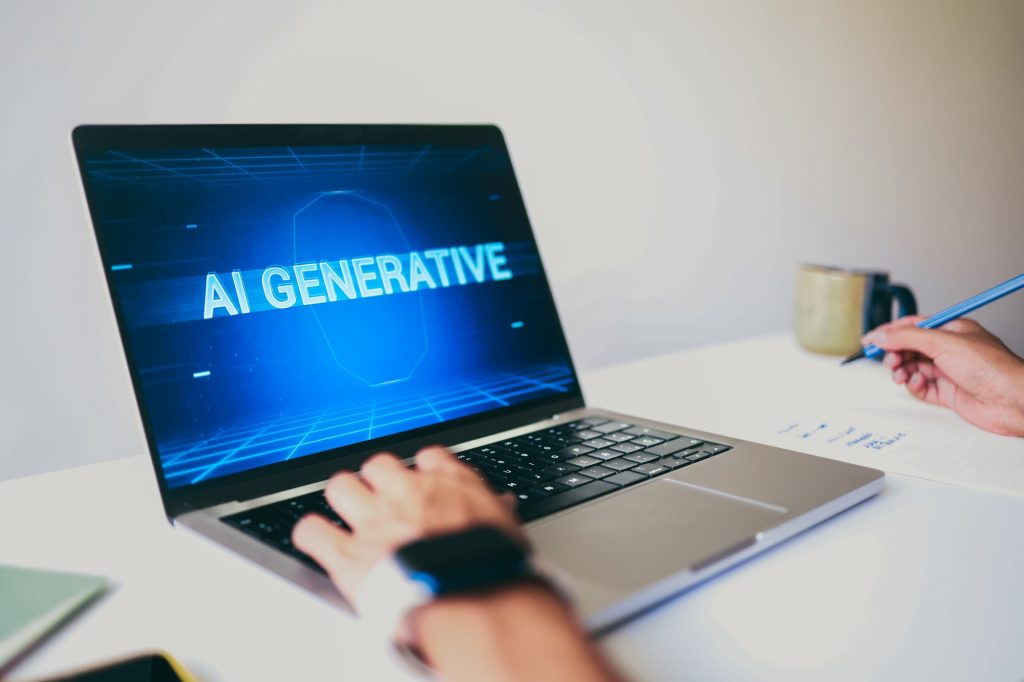Generative AI has evolved faster from a new technology into a worldwide phenomenon. Organizations worldwide have embraced these powerful tools, with 54% already putting them to use. The AI boom in the 2020s has led to amazing adoption rates. China leads the pack with 83% adoption, which is a big deal as it means that the U.S. rate of 65%. McKinsey’s research suggests generative AI could add up to $4.4 trillion to the global economy each year. This technology could boost global GDP by 7% and lift productivity growth by 1.5 percentage points in the next decade.
Generative AI stands out because it creates new, original content that matches human-created work. These systems can take text, images, audio, and code as inputs and turn them into fresh outputs of all types. This piece breaks down what generative AI is, how it works, and its uses in industries of all sizes – from financial services and healthcare to manufacturing and entertainment. AI adoption has doubled in the last five years. Gartner predicts that more than 80% of organizations will use generative AI applications by 2026. Everyone needs to understand this technology now more than ever.
A Brief History of Generative AI
The rise of generative AI covers many decades. It started with simple statistical models and grew into the sophisticated systems we use today. This trip through time shows how computer creativity developed from simple algorithms into complex neural networks that can create content that sounds remarkably human.
From Markov Chains to AARON (1906–1990s)
Generative AI’s foundations go back to the early 20th century. Claude Shannon published “A Mathematical Theory of Communication” in 1948. He introduced n-grams—statistical models that could create new text based on existing patterns. Alan Turing proposed the famous Turing Test in 1950. This test became a measure of machines showing intelligent behavior that humans couldn’t tell apart from their own.
The 1960s saw the first working generative systems come to life. Joseph Weizenbaum built ELIZA in 1961, which became the first talking computer program. It acted like a psychotherapist in text conversations. While basic by today’s standards, ELIZA marked a most important step forward in machine-generated responses.
British painter Harold Cohen started working on AARON in the 1970s. This system became one of the longest-running AI programs in history. Cohen used a Data General Nova computer at first, then moved to PDP-11s and VAXs. He created a program that could make visual artwork on its own. AARON became known as the first AI image generator by 1973. It showed that machines could understand art basics and create original pieces.
The 1980s brought big changes in theory. Scientists introduced Recurrent Neural Networks (RNNs) in the late 1980s. These networks let machines model longer patterns and create more extended content sequences. Long Short-Term Memory (LSTM) networks came next in 1997. They improved how AI systems processed data in sequence and understood order.
Music also saw early AI creation. The “Illiac Suite” from 1957 (later called “String Quartet No. 4”) became the first computer-composed musical score. It used various algorithms, including Markov chains.
The Rise of Neural Networks and GANs (2014–2019)
Modern generative AI took off in 2014 when Ian Goodfellow created Generative Adversarial Networks (GANs). This groundbreaking approach uses two competing neural networks:
- The generator network creates content (images, text, etc.)
- The discriminator network checks if that content looks real
These networks compete and improve together. The generator creates outputs that become harder for the discriminator to spot as fake. After thousands of rounds, they can produce amazingly realistic content.
Other generative models appeared during this time:
- Variational Autoencoders (VAEs) for learning representations of data
- Diffusion models for gradually transforming data into noise and back
- Flow-based models for further improving image generation
The transformer architecture arrived in 2017 and changed everything. Unlike older models that worked through sequences step by step, transformers could handle all parts at once. This made them nowhere near as slow at understanding language context. These transformers became the foundation for powerful language models, including OpenAI’s first GPT in 2018.
StyleGAN showed up in 2019 and proved it could create incredibly realistic faces. Users could control features like position, age, and mood with amazing precision.
The ChatGPT Era and Multimodal Models (2020–Present)
ChatGPT launched in November 2022 and changed the game. It reached one million users in just five days. Running on GPT-3.5, this system showed it could generate clear text and have meaningful conversations that stayed on topic.
The field grew beyond just text. OpenAI released DALL-E in 2021, which could turn written descriptions into lifelike images. Stable Diffusion (2022) and Midjourney came next as powerful open-source options for creating images from text.
Recent work focuses on combining different types of media. GPT-4, which came out in 2023, can write up to 25,000 words—much more than earlier versions. Google’s Gemini and OpenAI’s GPT-4o (“omni”) represent the latest breakthrough. They naturally work with text, code, audio, images, and video all at once.
These multi-talented systems help humans and computers work better together. To name just one example, GPT-4o can have live voice chats that sound almost human. This opens new ways for people to work with AI systems.
Generative AI keeps moving forward. These historical steps help us understand what’s possible now and where this fast-changing technology might go next.
What is Generative AI in Simple Terms?
Generative AI marks a revolutionary change in artificial intelligence. It goes beyond analyzing existing information to create something new. People are fascinated by this technology because it produces content that sounds remarkably human.
Definition: Generating New Content from Patterns
Generative AI systems create original content by learning patterns from vast datasets. These systems learn simplified versions of their training data and use them to generate new outputs that look similar to the original data. Neural networks help the technology spot patterns and structures in existing information to produce fresh content.
The principle behind these systems is straightforward yet powerful. They learn statistical patterns in data—text, images, audio, or code—and generate new outputs when prompted. To name just one example, after training on Wikipedia or Rembrandt’s works, they can create text or images that mirror those styles.
These AI models work as advanced prediction engines. They predict which words, pixels, or sounds would naturally follow to create meaningful content based on the given prompt. This lets them generate complex and varied outputs.
How It Is Different from Traditional AI
The biggest difference between generative AI and traditional AI lies in their basic approach and what they can do:
- Traditional AI: It analyzes existing data to make predictions or decisions. Traditional AI excels at classification, pattern recognition, and optimization tasks—it studies what exists to decide about new inputs.
- Generative AI: It creates new data that matches its training data. Pattern creation, not just recognition, is its strength.
This shapes how these systems work. Traditional AI might analyze customer data to predict buyers, while generative AI creates tailored marketing content for each customer. As one expert puts it, “Traditional AI can analyze data and tell you what it sees, but generative AI can use that same data to create something entirely new”.
Foundation models are another key feature of generative AI. These large neural networks train on huge datasets and serve as building blocks for various applications. They show unexpected abilities their creators never programmed, like GPT-4 writing poetry without specific poetry training.
Examples of Generative AI in Daily Life
Generative AI has merged into our daily lives faster than we realize:
- Text and conversations: ChatGPT and similar chatbots write essays, answer questions, and participate in natural conversations.
- Visual content: DALL-E and Stable Diffusion create images from text descriptions. Other systems generate videos or 3D models.
- Audio and music: AI tools produce original music, clone voices, and create sound effects based on prompts.
- Personal assistance: Siri and Alexa use generative capabilities to give natural responses and tailored recommendations.
- Productivity tools: Microsoft Copilot and Google Gemini merge AI directly into common apps like word processors and email.
The technology also powers many background processes. It creates synthetic data to train other AI systems, generates code for software development, and produces realistic simulations for scientific research.
Each new advance makes AI-generated content harder to tell apart from human work as the technology spreads to new areas.
How Does Generative AI Work?
Generative AI’s ability to create content might seem like magic, but it works through a complex multi-phase process. These AI models work in different stages that help them produce content that sounds more and more human-like.
Training Phase: Learning from Unlabeled Data
Generative AI starts with training on huge datasets. Unlike regular AI systems that need labeled data, these models learn on their own from unlabeled content. This lets them find patterns without anyone having to sort the data first.
The model looks at about 45 terabytes of text data in this original phase. That’s like having a million feet of books or a quarter of the Library of Congress. This massive amount of data helps the model understand language patterns, how concepts connect, and subtle context clues.
The model saves what it learns in vector databases, which store data points like coordinates in many dimensions. Just as we use latitude and longitude to find places on maps, these vector representations help the model spot “nearby” data points and connect related ideas.
Tuning Phase: Fine-Tuning for Specific Tasks
After training the base model, it gets fine-tuned to work better for specific jobs. This means more training with smaller, specialized datasets that help the model adapt to particular areas or tasks.
Fine-tuning brings several benefits:
- Better outputs for specific tasks
- Stronger model performance
- Faster and cheaper processing thanks to shorter prompts
There are two main ways to do this:
- Parameter-efficient tuning (adapter tuning): Changes just a few model settings, which needs less computing power
- Full fine-tuning: Updates everything, which might work better but needs more resources
Supervised fine-tuning teaches models new skills through examples that show what we want them to do. This works great for sorting things, analyzing feelings in text, finding specific information, and creating specialized content.
Generation Phase: Producing New Outputs
The model predicts what should come next based on the given prompt during generation. For text, it guesses the most likely next word or phrase based on what came before, and keeps going until it finishes the response.
The system uses its huge network of connected vector nodes—sometimes billions of them—that show how words relate to each other. These connections are the AI’s “model” and let it create content that makes sense in context.
The output feels real to us because the model learned from things humans read, like Wikipedia and e-books. The way it actually works inside remains mysterious even to the experts who build it.
Reinforcement Learning with Human Feedback (RLHF)
RLHF makes outputs better than standard training alone. This method helps models match what humans want through four steps:
- Human feedback collection: People rate how good, natural, and helpful the model’s outputs are
- Reward model training: These ratings train a separate model that predicts how humans would judge responses
- Policy optimization: The main model uses this information to improve its outputs
- Continuous improvement: The model checks possible responses and picks ones humans would like best
RLHF helps models create content that’s more truthful, safe, and useful—things that are hard to teach through regular training.
Retrieval-Augmented Generation (RAG)
RAG is a new way to fix some of generative AI’s biggest problems. It makes outputs better by checking trusted sources outside the model’s training data before creating responses.
This approach helps by:
- Getting newer information than what the model was trained on
- Making facts more accurate by checking reliable sources
- Showing where information comes from
RAG turns user questions into vector form and matches them with relevant facts from outside databases. The model gets both the question and this extra information to create better answers.
RAG is an affordable way to make model outputs better without starting over with training, which makes generative AI more useful in many fields.
Core Model Architectures Explained
Modern generative AI applications rely on four fundamental architectures. Each architecture brings its unique approach to content creation. These technical frameworks are the foundations of systems that generate everything from images to text to music.
Variational Autoencoders (VAEs)
VAEs function as deep learning models that encode data into a compressed form before decoding it to create variations of the original input. These models differ from traditional autoencoders by encoding data as probability distributions instead of fixed values. This allows them to create diverse outputs that mirror training data.
VAEs shine with their dual-network structure. The encoder compresses input data into latent variables that capture key features, while the decoder rebuilds or generates new data from these variables. This probabilistic method helps VAEs learn patterns and create variations that go beyond exact copies.
VAEs encode two vectors for each latent attribute: means (μ) and standard deviations (σ). The model samples from these distributions to blend unique outputs that stay statistically similar to original data. The training balances two key parts: reconstruction loss that measures input-output similarity and Kullback-Leibler divergence that keeps the latent space structured.
These models excel at controlled generation, anomaly detection, and creating synthetic training data. However, they often produce lower-quality images compared to newer architectures.
Generative Adversarial Networks (GANs)
GANs changed generative modeling through an adversarial approach that uses two competing neural networks:
- The generator creates synthetic data to mimic real examples
- The discriminator tries to spot differences between real data and the generator’s creations
This competition drives both networks to improve through training. The generator starts by producing obviously fake data but gets better as the discriminator provides feedback. Optimal training leads to the generator creating outputs so realistic that the discriminator can’t tell them apart from real data.
GANs create sharper, more realistic outputs than VAEs. Yet they come with bigger training challenges, especially instability and “mode collapse” where generators create limited sample varieties.
Diffusion Models and Denoising
Diffusion models represent a newer method that has gained traction in image generation tools like Stable Diffusion and DALL-E. These models work through a two-phase process:
Forward diffusion adds noise to data gradually according to a set schedule. Clean images start at time step t=0 and become progressively noisier until reaching pure noise at step t=T.
The reverse diffusion process learns to remove noise step-by-step. A neural network (usually a U-Net) learns to predict and eliminate noise at each step during training. This denoising continues until a clean image emerges.
Training aims to minimize differences between original data and the network’s prediction. Trained diffusion models can create new content by starting with random noise and applying the learned denoising process repeatedly.
Transformer Models and Self-Attention
Transformer architecture powers the most advanced language models including GPT and BERT. These models process entire sequences at once through self-attention mechanisms, unlike previous sequential models.
Transformers stand out in how they assess relationships between sequence elements. Self-attention helps the model determine which input parts matter most to each other. This helps transformers understand context across distant elements better than previous architectures.
Each sequence element in transformers generates three vectors:
- Query vectors that show what information an element needs
- Key vectors holding information other elements might want
- Value vectors delivering actual content when relationships form
Transformers can process data in parallel, making them perfect for training on massive datasets. This explains why they’ve become the backbone of today’s most sophisticated text-generation systems.
What is Generative AI Used For?
Generative AI has found its way into businesses of all types. Five areas stand out that show how versatile and ground-based these tools can be. These technologies are changing how we work and create, from making original content to powering trailblazing solutions.
Text and Code Generation
Generative AI shines at creating written content and functional code. Software developers use these systems to create, optimize, and auto-complete code. This streamlines the development process for both seasoned and new programmers. Programmers type plain text prompts that describe what they need, and the AI suggests code snippets or complete functions. These tools can also translate code between programming languages, which helps modernize projects like converting COBOL to Java.
The AI doesn’t stop at code. It helps create marketing materials, product descriptions, and technical documentation. Marketing teams use these tools to develop consistent, on-brand content and spend less time on repetitive writing tasks.
Image and Video Creation
Generative AI tools have changed the visual content creation world. Systems like Adobe Firefly turn simple text prompts into professional-looking video clips that work great for presentations, storyboards, and social media content. These tools can create everything from 3D graphics to photorealistic renders based on text descriptions.
The latest AI video generators can create matching audio with the visuals. They add dialog and sound effects to provide complete multimedia experiences from basic prompts. Creative professionals love these tools because they can generate special effects like smoke, water, and fire. They can also create b-roll footage without traditional filming.
Audio and Music Synthesis
Generative AI creates sound in many different ways. Advanced models like Stable Audio 2.0 can create high-quality tracks up to three minutes long through a new way of audio-to-audio generation. People can upload audio samples and change them into various sounds using natural language prompts.
These technologies work well in several fields:
- Music composition and sound design
- Ambient sound creation for film and gaming environments
- Voice synthesis and audio effects generation
This makes virtual environments more immersive by creating realistic soundscapes that match what’s happening on screen.
3D Modeling and Simulation
Generative AI keeps making great strides in 3D content creation. MIT researchers have created new techniques that let AI make sharp, high-quality 3D shapes from text descriptions. Unlike old-school 3D modeling that needs lots of manual work, generative AI creates fully-formed 3D models from simple text prompts.
These tools help create game-ready assets with proper mesh, textures, and animations—everything needed for virtual environments. Designers and engineers use generative design AI to optimize structures. The AI thinks over things like material usage, structural integrity, and cost.
Synthetic Data for Training AI
The sort of thing I love about generative AI is how it creates synthetic data—artificial information that looks like ground data but doesn’t contain actual real-world observations. Companies make use of synthetic data for research, testing, and machine learning development when real data is hard to get, costs too much, or contains sensitive details.
Synthetic data works especially well in healthcare. It can create patient records or medical images without including sensitive personal information. Financial companies like J.P. Morgan use synthetic data to boost their fraud detection. They create more examples of fraudulent transactions to train their models better.
Benefits of Generative AI for Individuals and Businesses
The estimated economic potential of generative AI ranges from $2.6-4.4 trillion annually based on analyzed use cases. This represents a big deal as it means that businesses and individuals can transform their operations. The technology brings real benefits in many areas.
Boosting Productivity and Creativity
Generative AI improves workplace efficiency by a lot through task automation. Tools like GitHub Copilot have made development cycles shorter and let engineers work “like ten”. The numbers prove this boost – new and junior developers completed 27-39% more weekly tasks. Senior developers saw gains of 8-13%. One engineer pointed out that “applications that would have taken a month can be written in a weekend”.
The benefits go beyond just coding. A GenAI recruitment tool helped a manager save three hours while going through 20 resumes. The technology also boosts creativity – especially if employees take time to think about and adjust how they use it.
Accelerating Research and Innovation
Generative AI speeds up breakthroughs in R&D through faster pattern recognition and data processing. The technology shines at:
- Creating more design options with greater variety
- Testing candidates through AI surrogate models
- Making knowledge management better
About 44.1% of AI users keep using it for research. The technology makes a huge difference in life sciences, especially for drug discovery. Industries that mainly produce intellectual property could see innovation rates double.
Enhancing Personalization and User Experience
Companies can now deliver customized experiences at scale with generative AI. The mass-market approach is giving way to individual tailoring. Automotive companies can now match their messages to each customer’s priorities – some hear about luxury and comfort while others learn about engine power.
This targeted approach works well. About 47% of customers value deals that line up with what they want to buy. People trust retailers more (24.8%), feel less overwhelmed while shopping (37.7%), and believe businesses understand them better (31.5%).
Reducing Costs in Content Creation
Content creation costs drop sharply when teams adopt generative AI. One test showed the technology cut production time from four hours to 30 minutes – bringing costs down by 91%. Companies could save over $100,000 in five years.
Teams that use AI-driven automation in their content work usually cut manual hours by 30-50%. Creative teams can focus on strategy instead of repetitive work.
Risks, Limitations, and Ethical Concerns
Generative AI offers remarkable capabilities but comes with substantial risks that just need careful evaluation. These challenges span from incorrect facts to broader effects on society that we need to manage wisely.
AI Hallucinations and Inaccurate Outputs
AI systems often create convincing but false information—experts call this “hallucination.” Analysts found that chatbots hallucinate approximately 27% of the time by 2023, and factual errors show up in 46% of generated texts. These false outputs create serious problems in professional settings. Lawyers faced penalties after submitting briefs with fake court cases cited by AI. A study revealed that 47% of ChatGPT’s references were completely made up.
Bias in Training Data and Outputs
Bias remains a core problem in generative AI systems. UNESCO research showed these systems link women to words like “home” and “family” four times more often than men. One system generated images of only men—90% of them white—when asked to create pictures of “CEO giving a speech”. Even with greater awareness, 71% of organizations admit they don’t do enough to handle bias in generative AI.
Deepfakes and Misinformation
Synthetic media that looks real—known as deepfakes—poses a growing threat to truth and trust. Almost all deepfake videos (90-95%) since 2018 were non-consensual pornography. These fakes hurt businesses too. A single fake image caused a stock market panic in 2023.
Job Displacement and Economic Impact
Goldman Sachs reports that generative AI could replace up to 300 million full-time jobs in the U.S. and Europe. McKinsey projects that by 2030, this technology would automate 29.5% of work hours in the U.S. economy. The effects vary between genders—36% of women work in jobs where AI could save half the time on tasks, compared to 25% of men.
Environmental and Energy Concerns
Generative AI leaves a huge environmental footprint. Training models like GPT-3 uses 1,287 megawatt hours of electricity—enough to power 120 average U.S. homes yearly. AI data centers need massive amounts of water for cooling. Each kilowatt hour of energy uses about two liters of water. Hardware demands keep growing rapidly. GPU shipments to data centers jumped from 2.67 million in 2022 to 3.85 million in 2023.
The Future of Generative AI: Trends and Predictions
Generative AI is about to make several breakthrough developments that will push its capabilities way beyond what we see today. Research is moving faster, and four trends will shape how these systems develop in the coming years.
Agentic AI and Autonomous Agents
Agentic AI marks the next big step in artificial intelligence. These systems move beyond simple conversations to independently think, plan, and finish tasks for humans. AI agents don’t just wait for commands – they actively work toward goals with little supervision. By 2028, AI agents will make at least 15% of work decisions, up from zero in 2024. This technology aims to increase human capabilities by handling data-heavy, repetitive work so people can focus on creative and strategic tasks. The AI agent market will grow to $52.60 billion by 2030, with a yearly growth rate of about 45%.
Multimodal and Real-Time Generation
As agentic AI grows, multimodal AI keeps getting better. These systems blend text, images, audio, and video to create deeper, context-aware results. Models like GPT-4 Vision and Gemini 2.5 show impressive capabilities by:
- Processing multiple types of input at once
- Creating responses in different formats
- Keeping context across different types of media
- Creating fewer errors through complete understanding
Live generation has become crucial. New tech enables instant translation during video calls, dynamic content creation, and split-second responses that feel just like talking to a human.
Open-Source vs Proprietary Models
The battle between open-source and proprietary models shapes AI’s future. Open-source frameworks help innovation and accessibility but face big challenges. Unlike regular open-source software, AI needs massive amounts of data and energy – resources that big companies control. Proprietary models get billions in funding and might be sold cheap to gain market share. Safety issues with sharing powerful tech remain unsolved, as shown by discussions about Meta’s LLaMA models and potential misuse.
Regulatory and Legal Developments
AI regulations are changing fast at every level – international, national, and state. The European Union’s AI Act started in August 2024, and most rules will take effect in August 2026. This complete legal framework groups AI systems by risk level and sets rules for providers and users. Colorado’s AI Act will start in February 2026, while California passed 18 AI laws in its last session. These changes show growing attention to transparency, accountability, and responsible AI development.
Your Next Step with Generative AI
Generative AI is one of the most transformative technologies today. It has changed how we create content and interact with machines. This piece shows these systems’ journey from basic Markov chains to advanced multimodal models. These models now create text, images, code, and more with amazing human-like quality. Without doubt, the technology grows faster than ever, and each new version brings capabilities we once thought impossible.
The basic workings of generative AI make it a powerful tool across industries. These systems train on big datasets, fine-tune for specific tasks, and create new content through probability-based predictions. Software developers boost their productivity while pharmaceutical research moves faster with these tools. Creative professionals can now explore new ways to create content and focus on strategy instead of routine work.
In spite of that, major challenges come with these advances. AI hallucinations, built-in biases, job losses, and environmental issues need careful thought from developers, businesses, and policymakers. The difference between open-source and proprietary models makes the digital world more complex, raising questions about access, safety, and innovation.
The future looks promising with agentic AI and better multimodal systems that will push generative AI’s limits further. Different regions’ regulatory frameworks try to balance new ideas with needed protection. Generative AI is both a great chance and a big responsibility—a powerful tool that needs ethical use and constant monitoring.
Global adoption rates keep climbing, especially in China where 83% of organizations already use these technologies. These tools merge more and more into daily work and creative processes. Technical and ethical questions remain, but generative AI has changed how we create, analyze, and share content in the digital world forever.
Key Takeaways
Understanding generative AI is essential as it transforms from emerging technology to mainstream tool, with 54% of organizations worldwide already adopting these powerful content-creation systems.
- Generative AI creates original content by learning patterns from vast datasets, unlike traditional AI that only analyzes existing data to make predictions or classifications.
- The technology works through three key phases: training on massive unlabeled datasets, fine-tuning for specific tasks, and generating new outputs using probability-based predictions.
- Applications span text, images, audio, video, and code generation, revolutionizing industries from software development to creative content production with measurable productivity gains.
- Significant risks include AI hallucinations (27% error rate), embedded biases, deepfakes, and potential job displacement affecting up to 300 million positions globally.
- Future developments focus on autonomous AI agents and multimodal systems that can reason, plan, and complete tasks independently while processing multiple data types simultaneously.
The economic potential reaches $4.4 trillion annually, making generative AI both a tremendous opportunity and a technology requiring careful ethical consideration and responsible deployment across all sectors.
FAQs
What exactly is generative AI?
Generative AI is a type of artificial intelligence that can create new content like text, images, music, and code by learning patterns from large datasets. Unlike traditional AI that only analyzes existing data, generative AI can produce original outputs that often seem remarkably human-like.
How does generative AI work?
Generative AI works through a multi-step process. First, it trains on massive datasets to learn patterns. Then, it’s fine-tuned for specific tasks. Finally, it generates new content by predicting the most likely next elements (words, pixels, etc.) based on what it has learned and the input it receives.
What are some real-world applications of generative AI?
Generative AI has numerous applications across industries. It’s used for creating marketing content, writing code, generating images and videos, composing music, and even assisting in drug discovery. It’s also used in chatbots, virtual assistants, and for creating synthetic data for AI training.
What are the main risks associated with generative AI?
Some key risks include AI hallucinations (generating false information), bias in outputs, potential for creating deepfakes and misinformation, job displacement concerns, and environmental impacts due to high energy consumption. There are also ongoing debates about copyright and ethical use of AI-generated content.
How is generative AI expected to evolve in the near future?
Future trends in generative AI include the development of more autonomous AI agents that can independently complete complex tasks, advancements in multimodal systems that can process and generate various types of data simultaneously, and improvements in real-time generation capabilities. There’s also increasing focus on responsible AI development and evolving regulations to address ethical concerns.










